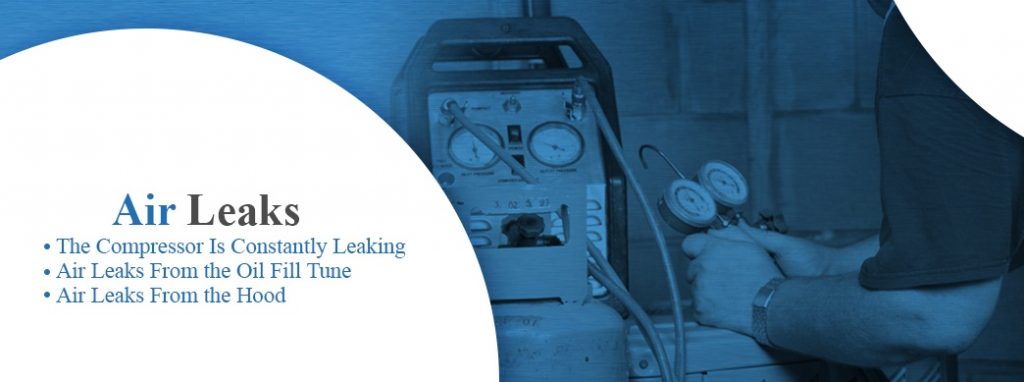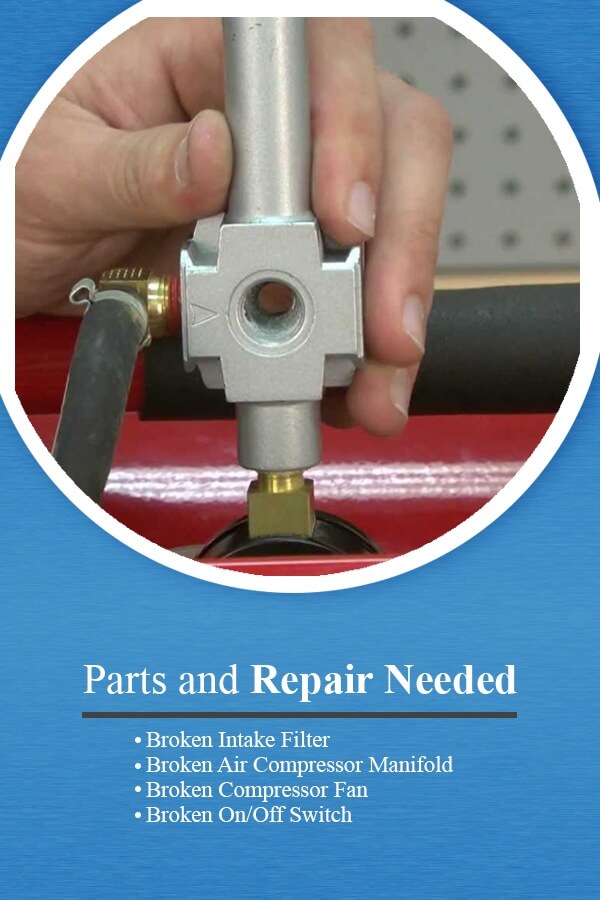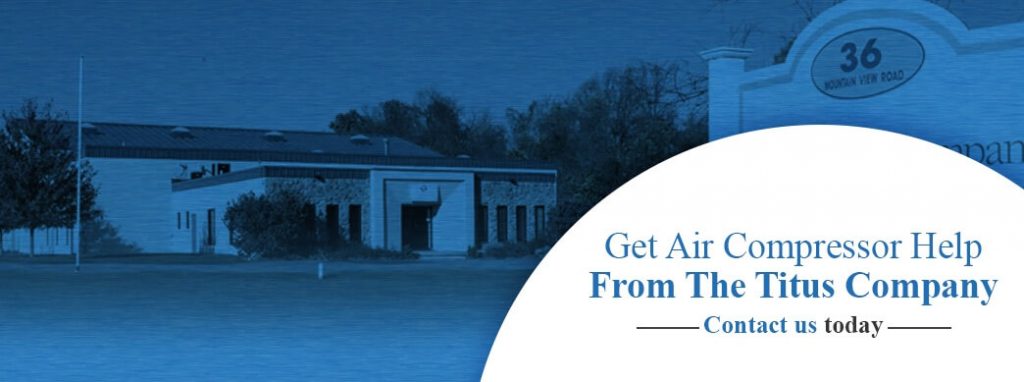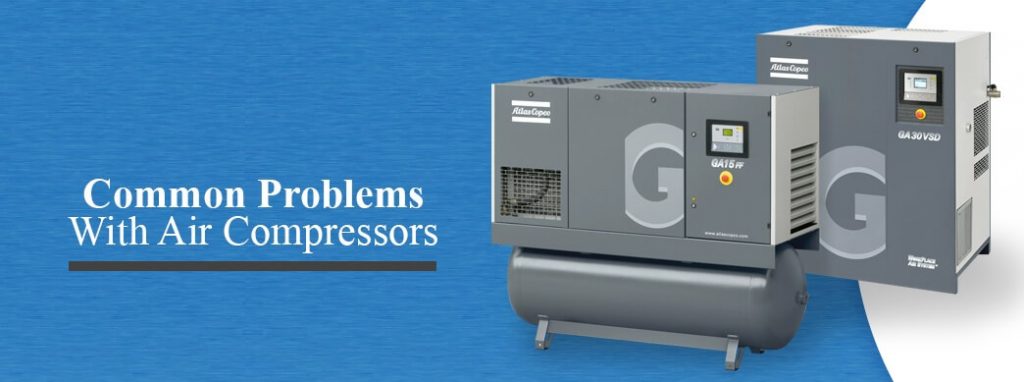Air Compressor Fills Up Then Struggles to Start Again to Refill
An air compressor problem could stem from one of many issues, such as an air leak, an oil leak or a broken role. In some cases, you lot might have insufficient pressurization or air period. In other cases, the compressor might fail to offset up or terminate running as prompted. Whatever the cause of the problem, the symptoms can be frustrating, costly and time-consuming.
Thankfully, most such problems can exist corrected with proper air compressor troubleshooting. The Titus Company has developed this troubleshooting guide for reference when your air compressor won't work. Whether you're hearing excessive noise from your portable air compressor or your organisation won't build pressure, yous'll find the cause here — and, hopefully, a solution. If non, call us. We'll exist there quickly with our 24/7 emergency services.
In This Commodity
- Air Leaks
- Compressor Is Constantly Leaking
- Air Leaks From the Oil Fill Tube
- Air Leaks From the Hood
- Electric Motor and Power Bug
- Compressor Blows Fuses and Breakers
- Dimmed Compressor Lights at Startup
- Billow Trips at Startup
- Won't First or Won't Stop
- Compressor Fails to Offset
- Compressor Fails to End
- Compressor Runs But Fails to Generate Air Pressure
- Oil in Air Lines
- Pressure and Flow Problems
- Obstructed Intake Filter Media-Element
- No Air From the Hose
- Air Simply Comes in Curt Bursts
- Parts and Repair Needed
- Cleaved Intake Filter
- Cleaved Air Compressor Manifold
- Broken Compressor Fan
- Broken On/Off Switch
- Get Air Compressor Help From The Titus Company
Air Leaks
Good air force per unit area is essential to a well-powered machine. When air is leaking from your tank or hoses, you'll discover low force per unit area, which brings on extra fourth dimension and energy costs that can exit your business backside. An air leak could exist down to ane of several factors. Fortunately, leaks can exist sealed with the right kind of air compressor troubleshooting. The following symptoms are among the well-nigh common leak-related air compressor issues:

ane. Compressor Is Constantly Leaking
If yous close off the air compressor on total charge, yet the approximate drops while the compressor is deactivated, you definitely take an air leak. The compressor might even automatically restart just to counter the situation. What yous demand to do in this situation is pinpoint the source of the leak.
- Utilise soap to the connections: With the compressor unplugged, embrace the connections with liquid soap, including all the couplers and the pressure level switch. If bubbles form at whatever point, that is where the leak is located. Tighten up the coupler, if possible, where the bubbles occurs.
- Inspect the tank cheque valve: Air leaks are sometimes caused by tank check valves that fail to shut completely. If the pressure gauge continues to drop when the tank is off, access the tank valve and audit its condition. The valve might need to be cleaned or replaced.
If the air leaks occur but when a hose is plugged into the compressor, disconnect the hose. If the pressure gauge stops dropping, the hose is the source of your leak.
2. Air Leaks From the Oil Fill Tube
If your compressor is losing force per unit area through the oil make full tube, check the piston seals. In most such cases, the piston seals volition be desperately worn and in demand of immediate replacement. This is a problem that you should remedy immediately, equally worn pistons can crusade metallic-on-metal friction that could swiftly pb to internal corrosion.
3. Air Leaks From the Hood
Air leaks from under the hood are sometimes encountered on smaller air compressors. To diagnose the trouble, remove the hood, run the compressor for a few minutes, then close it off and unplug the compressor. Experience around the motor parts for any sort of air draft. Chances are, the leak will originate from the tank valve, in which case you will need to remove and make clean or possibly replace the valve.
Electrical Motor and Ability Problems
If you notice an electrical event, you lot need to take a look at information technology or take a professional come up out as soon as possible. It could exist anything from your motor capacitors to misfiring piston rings. If the power cuts out on your air compressor — or the power is insufficient and unreliable — the problem is well-nigh probable down to one of the post-obit factors:
1. Compressor Blows Fuses and Breakers
Bold that your compressor is plugged into a working outlet and powered on, the following bug could be causing fuses to blow:
- Extension cords: If your compressor is connected to an outlet via an extension cord, the motor could be deprived of sufficient free energy, causing the motor to overheat. Compressors are not like home electronics, which can suffice on extension cords and power bars. An air compressor should just be powered through a direct connection to a ability source.
- An old motor: If your compressor has run on the same motor for many years, it could be fourth dimension for a modify-out. An older motor is liable to have worn windings, loose capacitor wires and other general clothing that could hands effect in blown fuses and breakers.
If the tank seems to lug at times of high pressurization, there is probably an issue with the motor capacitor.
two. Dimmed Compressor Lights at Startup
An air compressor consumes massive volumes of ability at the time of startup. This is known as the inrush, which vastly exceeds the corporeality of ability generally consumed throughout the residuum of a usage wheel. To prevent fuses from breaking during this inrush, compressor motors are equipped with starter capacitors, which manage the incoming power. A dimming light is i of the tell-tale signs that the starter capacitor is worn and due for a replacement.
3. Breaker Trips at Startup
If your air compressor trips off the moment it powers on, the effect is likely caused past trapped air over the pistons. To test for this problem, shut off the tank, unplug information technology from the power supply and drain the tank of all air. This should relieve the pistons of undue air pressure level and allow the tank to start without farther problems. Trapped air over the pistons is usually caused by a faulty unloader valve, which should exist inspected, cleaned and peradventure replaced if the event persists.
Won't Start or Won't Stop
When an air compressor fails to start upward, shut down or provide any caste of air pressure while active, the problem could be down to one of several issues. Each case should be taken on its own, as follows:
1. Compressor Fails to Starting time
Aside from the obvious oversights such equally a disconnected ability string or a deactivated power switch, a compressor volition typically fail to outset when it lacks sufficient air pressure level. If the cut-in pressure is not proportional to the amount of air pressure stored in the tank, the compressor will often fail to start. Bank check the cut-in setting on the pressure switch and adjust the level accordingly.
two. Compressor Fails to End
The compressor should stop one time the tank pressure drops to the cutoff point. If this fails to occur, the trouble volition generally be down to one of 2 issues:
- Faulty pressure release valve: If the valve fails to release pressure level, the tank will be too pressurized for the motor to stop running. In cases similar these, yous should cut the power and refrain from further utilise until the valve is replaced, as farther use could seriously damage the compressor.
- Faulty pressure switch: If the pressure level switch fails to bespeak the internal controls, a new switch should solve the problem.
Pressurization components are at the center of a compressor'due south functions and when they neglect, the compressor substantially fails.
3. Compressor Runs Simply Fails to Generate Air Pressure
If the compressor runs and runs yet air pressure level is not forthcoming, the trouble is likely due to one of ii issues:
- Faulty pump: If the motor is running and making racket yet no air comes out, you probably accept a faulty air-intake pump that needs to exist replaced. Equally long as the compressor is not too hot, you tin experience for lack of pump force per unit area manually with a pair of protective gloves.
- Faulty gasket: If the compressor only generates small amounts of pressure, there might exist an issue with the gasket between the low-pressure and high-pressure compartments of the compressor, such as air flowing from one side to the other without sufficient pressurization.
Fortunately, pumps and gaskets can easily be changed out. With a elementary parts replacement, you should exist able to get many more years of functioning from the compressor at manus.
Oil in Air Lines
If compressor oil works its mode into the air lines, the furnishings could exist detrimental elsewhere in the compressor considering the pump uses a unlike kind of lubricant than other parts of the system. Once inside the air lines, that oil will be dispersed to other areas, potentially causing seals to crack or swell. Oily air lines are well-nigh troubling when the oil travels to plastic parts of the air valve.
The ill-effects of oil on plastic are due to the additives in the oil, which tin cause plastic surfaces to become brittle and ultimately carve up. A plastic lubricator basin, for case, could split up nether such circumstances if the air pressure level crosses a certain threshold. You can protect the bowl — or contain the plastic in the consequence of a rupture — by affixing information technology with a metal shroud.
In a reciprocating air compressor, the oil must first travel by the piston seals to make its way to the tank. When this occurs, the seals should be replaced immediately. This would also be an opportune time to replace the valve and gasket.
As soon as you discover that oil has entered the air lines, check the sump to make sure that it still has a sufficient quantity of oil. If the problem persists, the sump could exist depleted of its oil supply.
When removing the oil, accept a look at information technology and ensure information technology appears clear and consistent. Sometimes, y'all may notice your oil has a milky await to it — this happens when your air compressor is exposed to excessive humidity and condensation has gotten into the oil reservoir. In this case, you should drain and replace the oil and move your air intake pipe to a less humid environs.
Pressure and Flow Problems
Some of the most common bug with air compressors involve issues with the pressure level and flow, which often manifest with the following symptoms:
1. Obstructed Intake Filter Media-Element
The main reason to supercede an intake filter is when it becomes corroded or damaged. However, the filter could be the source of pressure level and menses issues if the intake becomes plugged. Tell-tale signs of trouble include the following symptoms:
- The compressor tank takes longer and longer to build air pressure.
- The motor recurrently overheats and trips the thermal cut.
If you experience these problems, remove the filter housing from the intake pump and run the compressor over again. If the bug end and the compressor runs normally, the issue is rooted in the air intake media. From here, you have ii options — cleaning or replacing. To clean a compressor filter, run water through it until you lot don't see any clay particles.
Y'all can replace the media with diverse types of filter elements sold at supply stores and motorcar parts shops. The best options are media that resemble the kinds used in air conditioners. Cut the media to the dimensions of the intake filter and switch out the erstwhile for the new.
ii. No Air From the Hose
If an air hose is connected to your compressor nonetheless the air is not forthcoming, the issue could be downwards to one of several factors:
- The tank lacks air. This would be indicated past a zero pressure reading on the tank estimate.
- The regulator pressure is set to nil. If so, adjust the regulator to a level inside 20 psi of the compressor's cutout pressure.
- The belch coupler is fitted with the incorrect hose connector, thus blocking the menstruation of air. This could be the case if you lot recently replaced one of the parts without checking OEM specifications.
The problem could besides be down to the simple fact that the connector on the attached pneumatic tool is ill-suited for the coupler.
3. Air Only Comes in Short Bursts
If your tank has sufficient air quantity, yet generates very petty air pressure, bank check the gauge readings. If the judge is also low, you volition not get sufficient air pressure from the tank. If your tank gauge is 100 psi, the gauge should exist set to somewhere around 90 psi.
Parts and Repair Needed
If an air compressor seems to take stopped working due to a broken part, you get-go demand to test the function to verify the root of the problem. A compressor will not work if the following parts are cleaved. Fortunately, all can exist replaced:

ane. Broken Intake Filter
The intake filter is a crucial part of the air compressor because it strains impure particulates from the incoming air. Since it physically sticks out from the remainder of the unit, an intake filter is one of the more easily broken parts to an air compressor. Fortunately, information technology is also 1 of the easier parts to replace. As long as you find a filter with the aforementioned thread size and roughly the aforementioned portal size and diameter, it should work for your machine.
ii. Broken Air Compressor Manifold
If you lot break the pressure switch on an air compressor, you might be surprised by the underlying complexities. Fact is, any sometime replacement switch will not solve the problem due to all the connecting points of the manifold. To prepare the problem, you lot will demand to find a switch that accommodates each of the four or five connecting points, which will generally include sockets for the force per unit area relief valve, the air tank gauge, the compressor tank and the quick coupling.
Before you buy a new pressure switch and manifold, take note of the post-obit details on the old switch, each of which must exist matched on whatever new switch yous adhere to the compressor:
- The number of ports on your pressure switch and manifold.
- The voltage of the original pressure switch.
- The cut-in and cut-out settings on the onetime pressure switch.
- The hookup of the unloader valve.
Be careful to properly thread the ports of the new manifold onto their respective parts of your air compressor.
iii. Cleaved Compressor Fan
Many newer air compressors — particularly those on the lower-toll end of the spectrum — accident air with fans made of plastic, which is less expensive than metal but is also more than easily decumbent to wearable and tear. Fortunately, a replacement fan made of either material will work in most whatsoever compressor. Therefore, if y'all have a fan with broken plastic blades, yous could turn this into an opportunity to upgrade to metallic.
Before yous pick a replacement fan, check the compressor manual for a list of the part number and corresponding dimensions. If not found, measure the dimensions and the hole bore of the original fan. Accept annotation of the number of blades and the management of airflow, as both details are consequential to the performance and make of the compressor.
4. Broken On/Off Switch
If the motor of your air compressor fails to power on when you flip the switch, information technology could exist a thing of the switch itself, though you should run some tests before you draw any conclusions. Check the power cord to ensure that it is plugged into a performance socket. If the power switch nevertheless fails to activate the compressor, plug a light or electronic device into the outlet to see if that powers on.
If the outlet works for other devices but not your compressor, pull back the housing that confines the switch, remove it from the socket and check the compressor owner's transmission for specs on the switch. Make sure that your replacement switch will match the specs and fit the socket.
Get Air Compressor Assistance From The Titus Visitor
Air compressors serve all kinds of purposes on a professional as well as personal scale. From pressing plants and factories to repair shops and studios, pressurized air is used to assemble everything from automobiles and shipping to appliances and home furnishings. Today's compressors are designed to deliver optimal power with sleek designs through many usage cycles.
At The Titus Company, we offer maintenance on a variety ofair compressor types and brands.Contact us today to learn more nigh our products and services and how we tin help you fix an air compressor that won't work as intended.

Source: https://www.titusco.com/common-problems-with-air-compressors/

0 Response to "Air Compressor Fills Up Then Struggles to Start Again to Refill"
Post a Comment